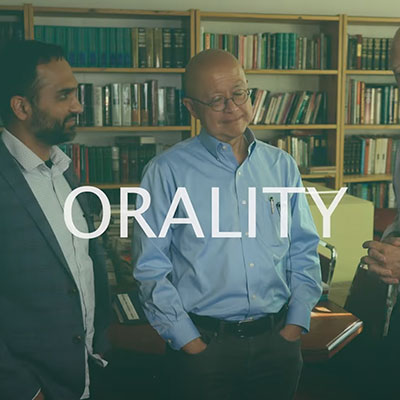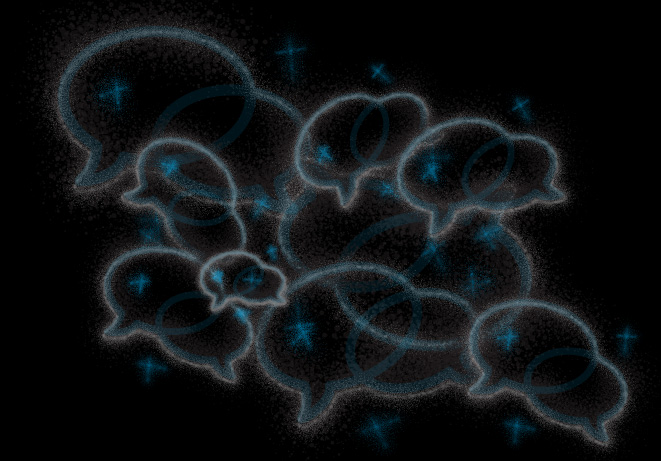What are the stories from the Bible you hold in your heart? Which did you hear as a child? Which ones have you told to your children? [. . .] Now, what if these stories were all in darkness? What if you couldn’t fully understand the foundation of the gospel because you never heard the whole story?[1]
Just under 10 percent of the world’s languages[2] have a full Bible. This is a sobering reality if we truly believe that people from every ethnos (nation), phylē (tribe), laos (people), and glōssa (tongue) will surround the heavenly throne of God as John saw in his vision in Revelation 7:9.
Furthermore, it is estimated that 45 percent of the world’s 7,300+ languages do not have a written form (orthography). These oral cultures present the traditionally text-reliant Bible translation movement with both a significant challenge and a momentous opportunity.
Orality and the Image of God
Orality is not a new concept. Rather, it is ‘an ancient phenomenon that continues to the present’.[3] In oral cultures, concepts such as history, identity, and religion are preserved orally through the passing along of stories, proverbs, poems, songs, riddles, and more. They are often woven into ceremonies, dramas, and rites of passage. Purely oral societies pass along everything that matters from one generation to another without putting anything into writing.
Orality is deeply connected to who we are as humans.
Oral communication, however, is not limited to purely oral cultures. We all learn our first language orally, and even after learning to read and write, we continue to rely on oral communication far more than we realize. This is perhaps most apparent today in the prevalence of audio-visual media, a form of communication that transcends divisions of generations, cultures, and literacy. Secondary oral communicators, those who are fully literate yet prefer oral means of communication, show us that oral strategies are not merely tools to place alongside others in our discipleship toolbox, nor are they simplified methodologies for the uneducated. Orality is, in fact, deeply connected to who we are as humans.
Indeed, the ‘text message’ of Scripture is only one of many methods that God has used to communicate with humanity.
After God spoke long ago in various portions and in various ways to our ancestors through the prophets, in these last days he has spoken to us in a son, whom he appointed heir of all things, and through whom he created the world. (Heb 1:1-2 NET)
We need only look at the marvel of creation, the rich tapestry of ritual and symbolism associated with tabernacle and temple worship, and ultimately the incarnation of God made flesh to see that the Scripture we have today is a written account of the many oral communication acts by which God passed his gospel of the kingdom to humanity.
Humans, as those made in God’s image, are therefore also designed for the spoken word, with text as a tool or technology[4] rather than the opposite. It is no surprise, then, that for a language to be considered ‘living’, it must have living speakers. We have volumes of text written in Latin and classical Greek, yet without any speakers, these languages are considered ‘dead’.
What do we do with written Scripture for the 1,800+ living languages without an orthography?
What then do we do with written Scripture for the 1,800+ living languages without an orthography? How do we give God’s Word to cultures and people groups who pass along ‘everything that matters’ without writing?
The Living Word for Living Languages
We place a high value on text today, especially when it comes to Bible translation. The traditional model of translation has required years of work to develop orthographies for languages that lack one. This must be followed by literacy work in the community before God’s Word can be translated or understood. That can result in a process of over 25 years for the production of a single translation.
And even with newfound literacy in a community and written biblical texts available, we have often heard the question asked, ‘If this message is so important, why is it hidden on the pages of a book?’ This question does not come from lack of capacity or intelligence in the target community, but rather from the value placed on the spoken over the written word for conveying truth within oral people groups.
This challenge should not surprise us. Consider that the Bible emerged from a world of oral communication where text played a much more limited role than it does in many cultures today. Jewish literacy in first century Roman Palestine has been estimated at less than three percent and was likely lower in Galilee, a rural area.[5] Jesus’ first disciples would almost certainly have been oral communicators. It has therefore been said that at this point in history, ‘[t]here was no reading public, only public reading’.[6]
A brief look at the language of the Shema from Deuteronomy 6:4–9, the central tenet of Judaism, reveals the oral nature of the recipient culture. God’s commands to Israel are almost entirely oral in nature (hear, teach, talk) and participatory (walk, lie, rise, bind). ‘Write’ does appear once, but only as the final command of a long list. Further language study across Scripture shows us that divine imperatives to listen (shema) outnumber commands to write (kathab and grapho) almost three to one.[7]
If Scriptures were first delivered orally to oral peoples and contained instruction crafted for oral communicators, does it not stand to reason that an oral approach to Bible translation is valid for oral people groups today?
If Scriptures were first delivered orally to oral peoples and contained instruction crafted for oral communicators, does it not stand to reason that an oral approach to Bible translation is valid for oral people groups today?
Oral Bible Translation–A ‘New’ Ancient Phenomenon?
Oral Bible translation (OBT) took place millennia before Walter Ong wrote his theories on orality. In the book of Genesis, for example, large portions of Joseph’s story take place in Egypt, where Hebrew was not the dominant language (Gen 42:23). All the dialogues from this period of Joseph’s life must, therefore, have been translated orally as the story was passed on in spoken form, until the text was committed to being written in Hebrew. Similarly, the speech of Jesus and his disciples, believed to be in Mishnaic Hebrew or Aramaic, appears to have been first written in Greek.[8]
Today the growth of new technologies allows us to adopt processes for OBT that, likewise, are entirely oral. Using one such software, Render, a team of mother-tongue translators can adopt all the same rigorous checks of a written translation—team checking, community checks, back translation, consultant checking—in a fully oral process. This helps them to work among their own people to render God’s Word clearly and accurately in a format they can understand and use.
In recent years, oral Bible storytelling agencies have taken on oral Bible translation due to growing demand from the field for ‘full Scripture’. New technologies are emerging, as well as grassroots organizations and movements to translate the Word for oral communities.
What makes these approaches stand out is that the communities they serve are no longer alienated from the process by virtue of a language or literacy barrier. Furthermore, the enormous impact for potential is multiplied by the instant shareability of an oral translation. ‘As soon as a recording is approved—whether a few verses or a whole book—it becomes available to share digitally with the local community.’ [9] This speed of access allows the good news to spread like wildfire!
ARTICLE
Towards a Theology of Orality
What does orality have to do with missions and L4? We’d suggest everything.
Young People and Collaboration–The Key to Multiplication
In December 2020, Youth With a Mission (YWAM) brought ‘fresh new eyes’, energy, and considerable human capital to the Bible translation movement when it presented its Oral Bible Translation 1000 goal: ‘At least 1,000 of these languages will have, at minimum, 30 “Taste & See” Scripture passages and a single-voice narration of a gospel film—either the JESUS film’s narration of Luke or the LUMO narration of Mark.’ YWAM’s strategy for this OBT 1000 initiative includes mobilising 72 training bases within strategic proximity to Bibleless languages.
Encouragingly, the broader Bible translation community has embraced YWAM’s efforts. YWAM’s members are partnering closely with Wycliffe Global Alliance partners including Faith Comes by Hearing, the 4.2.20 Foundation, the Institute for Biblical Languages, and the Bible and Literature Translation Association, among others. Together these organizations are using innovative and immersive source language training to develop mother tongue speakers to take the lead role in translating the Word of God into their own languages.[10]
This oral-first approach is allowing communities to have almost-immediate access to portions of God’s Word in a format they can understand. And YWAM is not alone, as their pioneering is encouraging and forging a path for more groups and agencies seeking to align with other partners to serve their own communities with oral Bible translations.
Challenges and Opportunities
What, therefore, can we recommend to the global church? I propose investing our hearts, prayers, and resources in three key areas:
- Advocacy: As oral methods and emerging technologies are adopted, we must help the wider community understand the authority and validity of oral Bible translations, as well as the use of the arts, recognizing that the Scripture we have today existed orally long before it was written. These oral forms must be considered an essential tool for discipleship if we wish to see the gospel of the kingdom embedded within a culture rather than received as an add-on to it.
- Collaboration: The whole church must be unified in its response to the tremendous need for full Scripture in oral forms. Partnerships such as those mentioned above have tremendous multiplication potential. Those involved are laying down stakes of ownership and investing their resources—human, financial, and more—towards the broader goal of ending the injustice of Bible poverty.
- Training: Likewise, the need for training—historically a text-heavy process—presents us with new opportunities. Immersive and oral pedagogies allow us to equip oral communicators with the highest level of training, so they can produce quality translations that stand the test of time.
The Ven. Canon Katete Jackson Jones from the Chama region of Zambia said the following after OBT began in the Senga community:
Once they had Scripture in the Senga language, the children began to say: ‘Jesus is Senga—how did he learn how to speak Senga?’ Oral Bible translation associates the Gospel with the people. Now we have the Bible in Senga. He lives with us. He is the Emmanuel.
This is the challenge and encouragement that I would like to end with: ‘Oral Bible translation associates the gospel with the people.’ If God felt the need to provide an oral counterpart to his Word in the form of his son Jesus, the living Word, how much more do we need to consider oral approaches as we present and embody his Word to the communities who are desperate to receive it? After all, spoken words have carried ‘everything that matters’ through countless generations. Isn’t it time to give oral communities what matters most?
Endnotes
- ‘The Original Testament Gap.’ 4.2.20 Foundation. video, https://theotgap.bible/resources/.
- ‘2022 Global Scripture Access.’ Wycliffe Global Alliance. September 2022. https://www.wycliffe.net/resources/statistics/.
- ‘What is Orality?’ International Orality Network. https://orality.net/about/what-is-orality/.
- Walter J. Ong. Orality and Literacy: The Technologizing of the Word. Routledge, 1982.
- https://faculty.biu.ac.il/~barilm/articles/to_check/illitera.html; Catherin Hezser. Jewish Literacy in Roman Palestine. Mohr Siebeck, 2001.
- John Walton. The Lost World of Scripture. InterVarsity Press, 2013.
- Research from David J Hamilton, 2023.
- Bryan Harmelink. Presentation at the 2023 OBT Global Gathering. Entebbe, January 2023.
- ‘Oral Bible Translation.’ Faith Comes By Hearing. n.d. https://www.faithcomesbyhearing.com/what-we-do/oral-bible-translation.
- Jim Killam. ‘”YWAM Has People” … and a Big Vision.’ Wycliffe Global Alliance. January 10, 2022. https://www.wycliffe.net/ywam-has-people-and-a-big-vision/.








